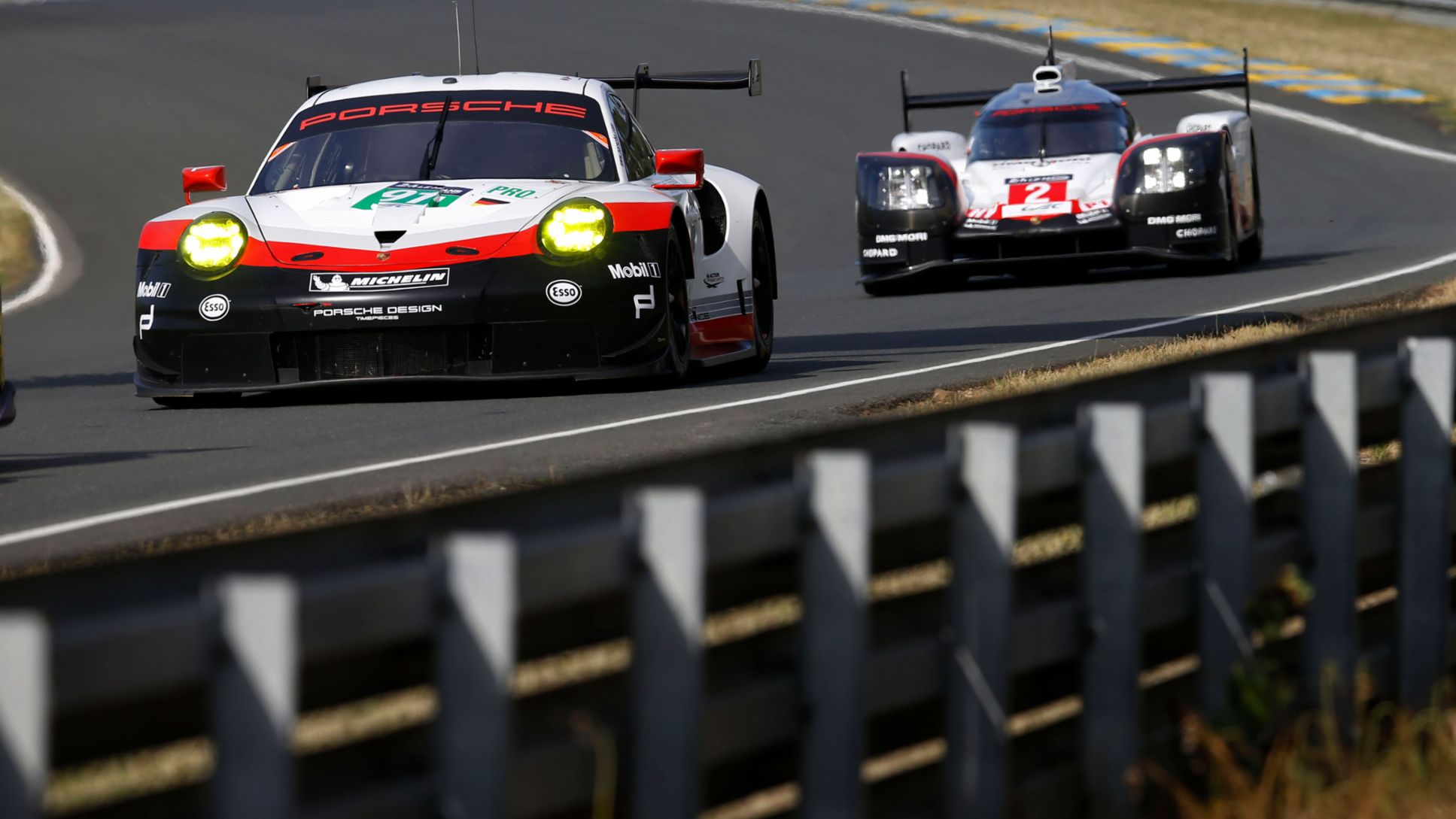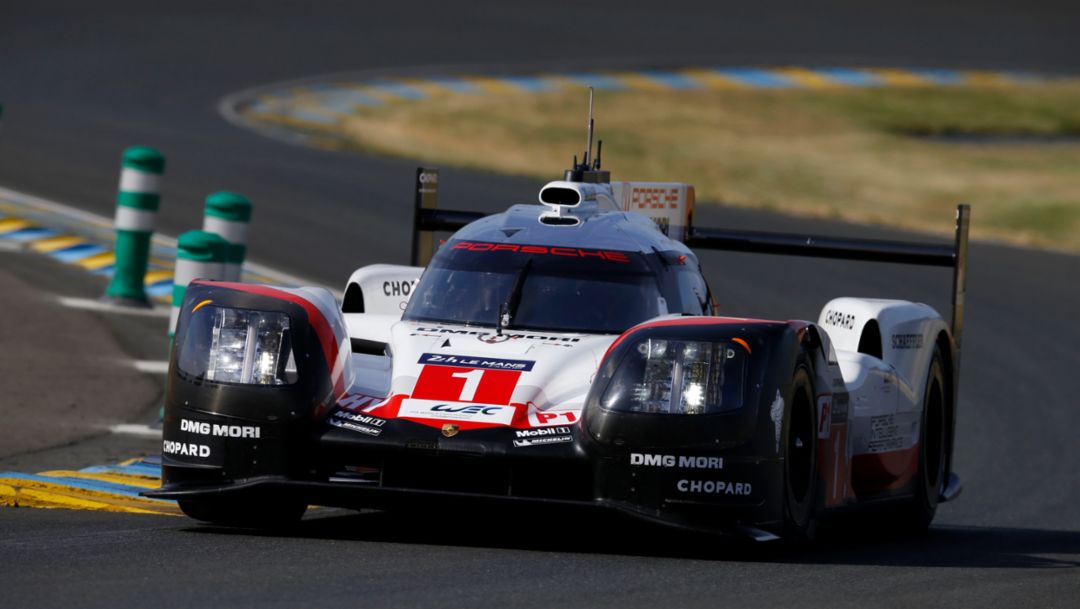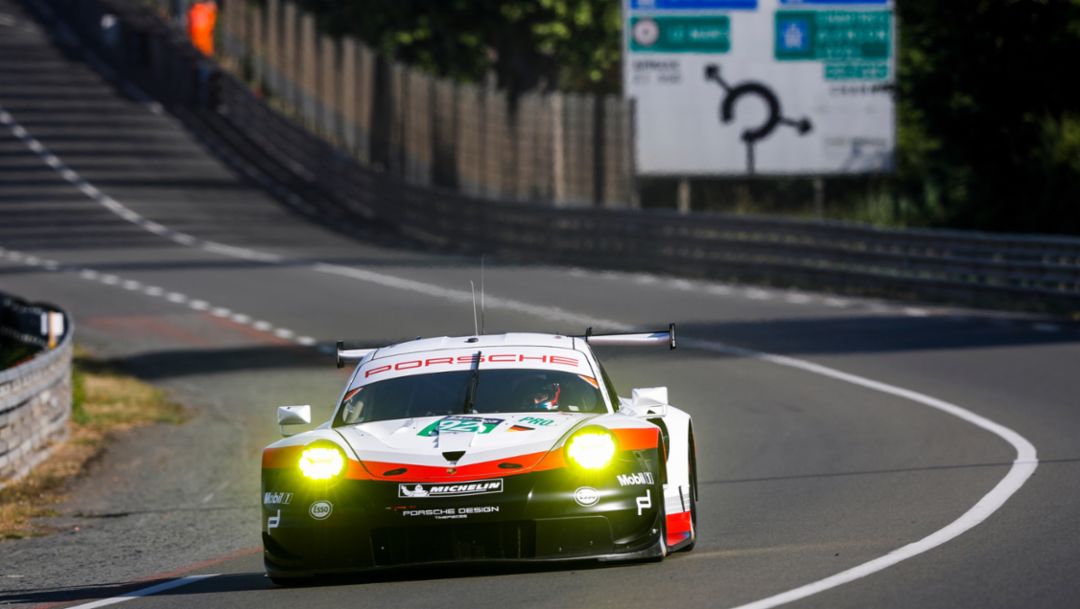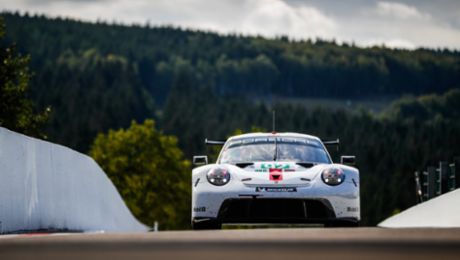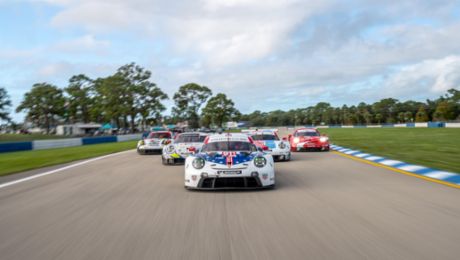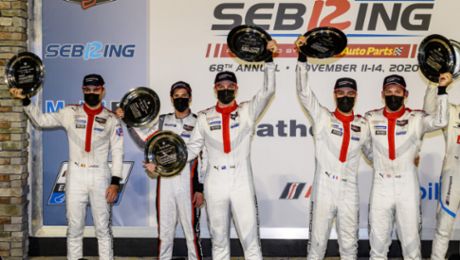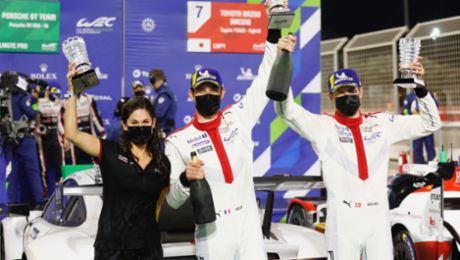LMP Team
Porsche will again fight for the crown jewels of endurance motorsports in attempting to win the 24 Hours of Le Mans for a third consecutive year. The toughest competition on track is Toyota. The Japanese manufacturer has yet to win Le Mans. In 2016, Toyota retired in a dramatic finish just minutes before the end of the race with a technical failure and in 2017 competes with three cars against the two Porsche 919 Hybrid in the top LMP1-H class.
Five overall winners in Porsche driver squad
Behind the wheel of the Porsche 919 Hybrid with start number 1 Neel Jani (33/CH), André Lotterer (35/DE) and Nick Tandy (32/GB) will alternate. The three drivers share a combined experience of 20 Le Mans starts and five overall victories. Jani (8 starts, 1 overall victory) is the only Le Mans title defender and reigning FIA World Endurance Champion in 2017 and is also the qualifying lap record-holder at Le Mans since 2015. Lotterer (8 starts, 3 overall victories) faces his first Le Mans race with Porsche after a successful career at Audi. For the second time, Tandy competes in the LMP1 class at the Sarthe. He raced there three times in GT and celebrated Porsche's 17th overall victory as an LMP1 rookie in 2015.
The crew of the sister car – Earl Bamber (26/NZ), Timo Bernhard (36/DE) and Brendon Hartley (27/NZ) – shares a total of 17 Le Mans participations and two overall victories. Bamber (2 starts, 1 overall victory) won in 2015 together with Tandy when he too was an LMP1 rookie. In 2016, he competed for Porsche in the GT-class. The most experienced of the trio is Bernhard: He has started Le Mans ten times, the first time in 2002 for Porsche in the GT-category – scoring a class victory on his debut. Since 2010, his name is also engraved on the trophy for an overall victory, when the Porsche works driver was loaned to Audi. Hartley (5 starts) has shared a cockpit with Bernhard since 2014 and is arguably the hungriest of them all: the big win at Le Mans has so far eluded him.
Comments before the race
Fritz Enzinger, Vice President LMP1: "Le Mans 2017 is going to be an extremely hard race, maybe even faster than 2016", Fritz Enzinger says in full awareness of the great contest. The Vice President LMP1 confirms: "This will not be a duel against Toyota alone. The toughest challenge at Le Mans is the race itself. You must not ever lose the respect for those 5000 kilometers covered day and night in changeable weather conditions and at speeds in excess of 330km/h while constantly overtaking and lapping competitors. There is no guarantee, things can happen at any moment. You only have a chance of winning the big trophy at Le Mans by fully preparing in advance, work flawlessly and then have an incident-free race.”
Andreas Seidl, Team Principal: “It is not just the sheer race distance that makes Le Mans the most difficult race in the world. You must pace yourself and manage resources during the entire event. It lasts over two weeks and during this time a workforce of 90 men work closely together in limited space and under great tension. They experience highs and lows together. That said on Saturday at 3pm, every single team member – whether mechanic, driver or anyone in the team – needs to be physically and mentally fresh for the race. That’s when it counts to execute all what we have learnt and practiced. We have done everything we could to be technically, and on the operational side, prepared for Le Mans. The Porsche 919 Hybrid, our strong driver line-up and the team are ready to give it everything.”
GT Team
The 24 Hours of Le Mans is an ageless classic. At the 85th edition contested, 60 cars and 180 drivers will again take up the challenge. With 18 overall and 105 class wins, Porsche is the most successful manufacturer in the history of this prestigious pursuit twice around the clock and is represented again this year by a large contingent. The Porsche GT Team fields two new 911 RSR in the famously cutthroat GTE-Pro class. This marks the debut at the world’s toughest automobile race for the 510 hp race car, which was developed by Porsche Motorsport in Weissach based on the seventh generation of the iconic 911 sports car. With two 919 Hybrid contesting the LMP1 class as well as four 2015-spec 911 RSR campaigned by Porsche customer teams competing in the GTE-Am class, a total of ten Porsche race cars, 13 Porsche works drivers and one Porsche Young Professional take on the Le Mans marathon.
The Porsche drivers
In the GTE-Pro class, Richard Lietz (Austria), Frédéric Makowiecki (France) and Patrick Pilet (France) share the cockpit of the new 911 RSR with the starting number 91. Their works driver colleagues, Michael Christensen (Denmark), Kévin Estre (France) and Dirk Werner (Germany) man the second Porsche 911 RSR (#92) fielded by the Porsche GT Team. In the GTE-Am class, Porsche customer teams take on the 24-hour challenge with four 911 RSR from the 2015 model year. In this class, the Porsche Young Professional Matteo Cairoli (Italy) celebrates his first ever Le Mans race. He shares driving duties in the #77 vehicle run by Dempsey Proton Racing with the two German racing drivers Christian Ried and Marvin Dienst. Porsche works driver Patrick Long (USA) tackles Le Mans for the 14th time, this time in the #93 Porsche 911 RSR campaigned by Proton Competition with Abdulaziz Turki Al Faisal (Saudi Arabia) and Mike Hedlund (USA). The drivers of Proton Competition’s second 911 (#88) is the former Porsche Junior Klaus Bachler (Austria) as well as Stéphane Lemeret (Belgium) and Khaled Al Qubaisi (Abu Dhabi). In Gulf Racing’s 911 RSR (#86), Ben Barker and Michael Wainwright from Great Britain join forces for the long-distance classic with Nick Foster (Australia).
Comments before the race
Dr. Frank-Steffen Walliser, Vice President Motorsport and GT Cars: “For sports car fans around the world, Porsche and Le Mans belong together. We are the most successful manufacturer in the history of this fascinating long-distance classic, and as such we have an obligation to uphold this tradition. That’s why we’re back again this year with a large squad. We’re particularly looking forward to debuting our new 911 RSR in the strongly supported GTE-Pro class, which is once again enormously competitive. To go up against four well-known manufacturers and eleven vehicles all manned by top pilots at this toughest and most spectacular race definitely poses the greatest challenge of the season for us.”
Marco Ujhasi, Director GT Factory Motorsports: “Le Mans is an extraordinary race that throws very special demands at us. For this reason, preparing for the season highlight is always very intense, especially when you compete with a new car. The main thing at Le Mans is to look after each vehicle over the course of the race so that we have a healthy car to attack in the final phase and fight for victory. We hope we succeed in this.”
Driver's quotes in the press release (see downloads).
Cars
The Porsche 919 Hybrid
The Porsche 919 Hybrid has been widely reworked for the 2017 championship. 60 to 70 per cent of the Le Mans prototype’s components are new developments. This especially concerns the areas of aerodynamics, chassis and combustion engine. However, the power train in principle remains the same. The innovative hybrid race car develops a system power of around 900 HP (662 kW) that comes from a compact two-litre turbo charged V4-cylinder (nearly 500 PS/368 kW) and two different energy recovery systems – brake energy from the front axle combined with exhaust energy. The combustion engine drives the rear axle while the electro motor boosts the front axle with an output of more than 400 PS (294 kW). The electrical energy that comes from the front brakes and the exhaust system is temporarily stored in a liquid-cooled lithium ion battery.
The Porsche 911 RSR
The 911 RSR, which celebrated its race debut at the Daytona 24-hour classic in January, is a completely new development: the suspension, body structure, aerodynamic concept, engine and transmission have all been designed in Weissach from scratch. Depending on the size of the restrictor, the motor, which is now positioned in front of the rear axle, puts out around 375 kW (510 hp). Thanks to the particularly large rear diffuser combined with a top-mounted rear wing, the level of downforce and the aerodynamic efficiency were significantly improved. The 911 RSR, whose predecessor model claimed a double victory at Le Mans in 2013, tackles the second 24-hour race of its maiden season again sporting the further developed factory design with the primary colours white, red and black.
Schedule
The technical inspection of the 60 racing cars, which are subdivided into four classes, begins on the Sunday before the race, June 11, at the Place de la République. It is a public event in the city centre. The scrutineers examine the cars while the 180 drivers must present their paperwork. The Porsche LMP Team is scheduled for this inspection on Sunday from 3:20 pm onwards (CEST).
Tuesday, June 13:
2:00-2:50 pm Porsche Team photograph on start/finish
5:00-6:30 pm Autograph session in the pit lane
Wednesday, June 14:
1:30-2:00 pm “Meet the Team” for media in the Team and Media Hospitality
4:00-8:00 pm Free practice
10:00 pm-midnight Qualifying
Thursday, June 15:
4:30-5:00 pm “Meet the Team” for media in the Team and Media Hospitality
7:00-9:00 pm Qualifying
10:00 pm-midnight Qualifying
Friday, June 16:
10:00 am - 6:00 pm Pit walk
2:00-2:40 pm Porsche press conference in the Porsche Experience Center
2:40-3:30 pm “Meet the Team” in the Porsche Experience Center
5:30-7:30 pm Driver parade in the downtown area
Saturday, June 17:
09:00-09:45 Warm-up
2:22 pm Beginning of race start ceremony
3:00 pm Start of race
TV and live stream
The Le Mans 24-Hours can be followed on various international TV channels all around the world. Detailed information for all individual countries is available at https://newsroom.lemans.org/24-heures-du-mans-en/ (click on “TV Distribution” in the download section).
Porsche websites: www.porsche.com/lemans offers a 24-hours web special with the live onboard cameras from the works cars’ cockpits. Additionally, the video stream offers interesting telemetry information about the current car conditions. Furthermore the website includes a live ticker and live standings as well as images and videos from the Le Mans race action.
Facebook: On Saturday at 3pm the race start is broadcasted live from onboard the best placed 919 Hybrid at www.facebook.com/porsche
App: The official WEC App can be downloaded free of charge with an extended (not free of charge) version available which includes full ACO live streaming and full timing of the Le Mans 24-Hours. The live stream is voiced and includes live interviews.
World Championship
Sports prototypes and GT vehicles contest the Sports Car World Endurance Championship (WEC) in four classes: LMP1 (eg. Porsche 919 Hybrid), LMP2, LMGTE-Pro (eg. 911 RSR) and LMGTE-Am (eg. 911 RSR model year 2015). They all compete together in one race but are classified separately. At Le Mans, double points are awarded in all classes towards the championship.
The 24-hour race is the third of nine rounds of the 2017 FIA World Endurance Championship. After the first two six-hour races (Silverstone and Spa), Porsche has scored 61 points and ranks second in the constructors’ standings behind Toyota (69.5). In the drivers’ standings Bamber/Bernhard/Hartley (33 points) are in second place with Jani/Lotterer/Tandy ranked third (28 points). The leading Toyota duo has 50 points.
The fascination of the Le Mans 24 Hours is as unique as the challenge for drivers and teams. This is not least due to the 13.629-kilometre Circuit des 24 Heures with its combination of a permanent racetrack and normal national roads. Also setting this racetrack apart are its legendary corners like Mulsanne and Tertre Rouge as well the almost five-kilometre-long Mulsanne straight. In the list of winners, the best racing drivers in the world have been immortalized. Even Hollywood has paid tribute to the prestigious long distance race in the French province: The 1970 film Le Mans featuring Steve McQueen in the lead role is regarded as one of the best racing movies of all time.
Story of success
Back in 1970, Porsche managed its first and long awaited overall race win at Le Mans. Until 1998 there were 15 more of that to follow, but then Porsche refrained from competing in the top category for 15 years and only scored some class wins. In 2011, Porsche decided to return with a prototype. The World Endurance Championship’s new efficiency regulations offered exactly what Porsche always was seeking in top level motorsports: a platform for research and development of future technologies for road cars.
2012 and ‘13 were dedicated to preparation. New buildings appeared at the Porsche R&D centre in Weissach near Stuttgart. Fritz Enzinger assembled a team that now numbers 260 highly qualified employees. The first Porsche 919 Hybrid was born – an entirely new car featuring hybrid technologies that were relatively previously unknown. The early days were difficult but the progress was significant.
2014 became the debut season of what remains today the most innovative race car in the world. At its first Le Mans attempt, 20 hours into the race, a 919 Hybrid took the lead but retired two hours later with an engine failure. In 2015, Porsche entered a third 919 Hybrid for Earl Bamber (NZ), Nico Hülkenberg (DE) and Nick Tandy (GB) and it was this trio of LMP1 rookies who took the 17th overall Le Mans win for Porsche – the first since 1998. Porsche repeated the overall race win last year courtesy of Romain Dumas (FR), Neel Jani (CH) and Marc Lieb (DE) after battling with Toyota for many hours.
Facts and figures
Since 2015 Neel Jani has held the qualifying lap record on the current track lay-out (13.629 km). Shortly after 10:00 pm in Wednesday’s qualifying that year, he achieved a lap time of 3:16.887 minutes with his 919 Hybrid. The average speed was 249.2 km/h.
The fastest qualifying lap ever was driven by Hans-Joachim Stuck in 1985 in a Porsche 962 C in 3:14.800 minutes (average speed 251.815 km/h). Chicanes were installed in 1990 to break up the long Mulsanne straight. On the current track, a lap time of under 3:14.843 minutes would be necessary to break Stuck’s record.
The fastest overall lap time, during what has so far been 84 events, was set by Jackie Oliver on the test day in 1971. Back then the track length was 13.469 km and he achieved a 3:13.6 minutes (average speed 250.457 km/h) in his Porsche 917. The same year, he achieved the fastest race lap in 3:18.4 minutes (average speed 244.387 km/h).
In 2016, Porsche managed the 15th front row lock-out at Le Mans when Neel Jani took the 18th Le Mans pole position for Porsche (3:19.733 minutes) with Timo Bernhard qualifying second (3:20.203 minutes).
The longest race distance was covered by Timo Bernhard/Romain Dumas/Mike Rockenfeller in 2010 in their overall victory for Audi, a total of 5,410.713 km (397 laps, average speed 225.228 km/h).
The race distance covered by the winning Porsche 919 Hybrid in 2015 was 5,382.82 km (395 laps, average speed 224.2 km/h). In 2016, the winning Porsche covered 5,233.54 km (384 laps, average speed 216.4 km/h).
The highest top speed with a 919 in the 2016 race was done by Brendon Hartley – 333.9 km/h down the Mulsanne straight on lap 50. The longest acceleration phase is after Tertre Rouge onto Mulsanne straight and measures 1,940 metres.
The toughest braking zone is at the end of Mulsanne straight when the drivers decelerate 200 km/h in only 190 metres.
The Circuit de 24 Heures features 21 corners (9 lefthanders, 12 righthanders).
The fastest of them are the Porsche Curves where the 919 Hybrid drivers go through at 245 km/h.
For the tightest corner, Arnage, the drivers slow down to 85 km/h.
9.2 km of the 13.6 km lap are normally public roads.
In qualifying (Wednesday and Thursday until midnight), all 180 drivers must run at least five laps in the dark.
The 2017 Le Mans night is one of the shortest of the year: the sun sets on Saturday at 10:00 pm, and it rises again on Sunday at 6:00 am.
In normal racing mode, the Porsche 919 Hybrid must refuel every 14 laps (maximum) and about 30 times during the race.
The maximum amount of fuel it may consume per lap (13.629 km) is 4.3 litres. The maximum amount of electrical energy from the recovery systems that it is allowed to use is 8 megajoules (2.22 kilowatt hours).
Refuelling and wheel changing may only be made sequentially, not at the same time. Only four mechanics may work simultaneously when wheel changing, using one wheel gun only. That takes a lot longer than, for example, in Formula One.
Drivers are normally only changed when new tyres are needed. At night they do quadruple stints which means a drive time of over three hours in a row.
During the race, each driver must get behind the wheel for a minimum of six hours in total. No driver may drive for more than four hours within a six-hour period. No driver may drive for more than 14 of the 24 hours.
Due to the length of the circuit, there are three safety cars at Le Mans.
The equipment taken to the track includes a spare chassis, four combustion engines, four front gearboxes, four rear gearboxes, six front and six rear sections, 60 rims and over 100 radios and headsets.
Different types of tyres can be used: three compounds of slick tyres for dry conditions, a hybrid tyre (no profile either but softer cover) for mixed conditions and wet weather tyres.
At Le Mans more than 260,000 spectators and around 1,400 media representatives (print, photographers, TV and online media) are expected.
Info
All scores: http://www.fiawec.com/courses/classification.html
All results: http://fiawec.alkamelsystems.com
